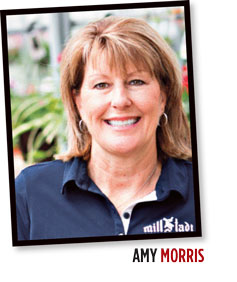2/1/2020
We Believe We Sell Plants, But We Really Sell Space
Amy Morris

Are we selling plants or are we selling square footage? Back in my father’s day, he would walk our customers through the greenhouse to show them where their product was going to be grown and spaced. He would tell them, “We’re growing your plants, but what we’re really selling is space.”
My father knew the key to growing quality product was quality spacing, so he understood that what we’re really selling is space. A lot of thought has to go into properly planning and spacing, otherwise you can run into a cram-fest, which will just result in poor quality.
We use a broad spectrum approach to our customer base footprint. From independent garden centers, big box stores, supermarkets, and yes, even seed and cutting companies. Our customer base is multifaceted. We keep it wide, which keeps us stable. So to meet the demand of such a broad customer base, we have to treat all of our customers, big or small, with our core philosophy: Grow quality and sell quality at the proper price.
Our main tools we use to build a successful foundation with our customers are quality and communication. The key to our success is, and always will be, based on our company’s roots of consistent quality. Our responsibility is to our end consumers. My father has preached to all of us: “You’re only as good as your last shipment.”
Tolerance for poor quality isn’t something he tolerated. Poor quality can happen with poor spacing and it can snowball. To avoid this, good use of space is essential. We can’t be willy-nilly with what goes where and when. A lot of time and effort goes into planning out every inch of our greenhouse. This allows us to avoid making spacing mistakes that can result in lesser quality. When deciding what to sell and what to grow for our customers, we have to keep in mind how much space is being used to ensure our customers get the absolute best quality.
Our company has been in business for 68 years and we continue to find inventive ways to grow. The important thing is all of our expansion is controlled, so it makes sense for our business. We grow by adding square footage and not by adding acres. Our biggest challenge for our business is the ability to expand physically, building new greenhouses with the margins we have to work with. We’ve learned over the years to be very creative to expand the business and make it work. We have to do it steady and slow so we can keep up with it. The cost of space is something we all need to be aware of to ensure the best quality for the price we’re receiving for that plant.
First, you have to figure out total square footage of usable growing space. It’s a whole process—you need to calculate overhead costs and then divide by 52 to get your weekly amount the overhead cost per square foot is. Then you add that number to the cost of raw goods, labor, marketing and transportation to reveal the cost of goods. And don’t forget to add shrink—it all adds up. We relook at the overhead per square foot on an annual basis and make our pricing changes accordingly.
More space for the plants usually equates to better quality. Proper spacing is essential to ensuring the plant grows to its best potential. However, we’re growing thousands of plants and they each require their own space, so it adds up.
One thing to also consider is the amount of time a plant is sitting in a space. It’s essentially renting that spot from future plants. (It’s as though you’re not just selling a space, you’re also selling a timeshare.) Some questions to consider include how many turns can you get in a season? Is the spec good? All of this has to be considered under a time restriction. These are products that have to be delivered as scheduled.
Space is becoming rare; this is the time to stop being timid about asking for a fair price for the space we’re using. Without a fair price, our industry cannot sustain itself for growth and stability.
We need to make sure we know who we are and where we really want to go and grow our company. Yes, we’re in the plant business. We sell quality plants, but we’re also selling quality spaces. That’s something to keep in mind for the future. GT
Amy Morris is Vice President of N.G. Heimos Greenhouses in Millstadt, Illinois. She can be reached at Amorris@ngheimos.com.